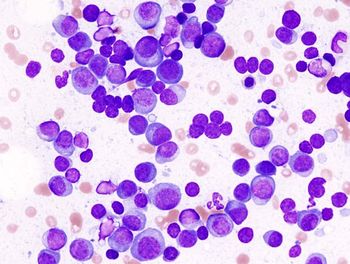
Flexible Monitoring for CAR T-Cell Therapy May Improve Treatment Access

Following rare CRS and ICANS incidence following CAR T-cell therapy, investigators propose a reduced 2-week monitoring period with extensions as needed.
Flexible monitoring for cytokine release syndrome (CRS) and immune effector cell-associated neurotoxicity syndrome (ICANS) following CD19-directed CAR T-cell therapies may help reduce financial and geographic limitations for patients with lymphoma, thereby increasing CAR T accessibility and feasibility, according to findings from a study published in Blood Advances.
Data showed that new-onset CRS and ICANS, respectively, occurred in 0% and 0.7% of patients with B-cell non-Hodgkin’s lymphoma (NHL) at 2 weeks following CAR T-cell infusion. Additionally, no new cases of CRS occurred after 2 weeks, with 1 additional incidence of ICANS occurring week 3.
Based on these findings, investigators proposed a 2-week monitoring period for patients who receive CAR T-cell therapy with the possibility of extending to 4 weeks depending on patient stability, physician comfort, and availability of local community oncology support.
“Currently, [CAR T-cell] therapy is not [like] your regular off-the-shelf drug that, if prescribed, you just get the next day,” lead study author Nausheen Ahmed, MD, an associate professor in the Division of Hematologic Malignancies and Cellular Therapeutics at the University of Kansas Medical Center, said in an interview with CancerNetwork®. “It's one of those therapies that has a lot of upfront investment with the patient's time. It does carry some financial and physical burden on the patient from the time of collection of the cells all the way up to the post-monitoring period. [Previous] work demonstrated that there are groups of patients who are not able to get CAR T or have a lower likelihood of getting CAR T—such as those from lower socioeconomic class—and those who may be from minority groups, especially African American groups.”
The Cell Therapy Consortium registry was used to identify recipients of commercial axicabtagene ciloleucel (axi-cel; Yescarta), tisagenlecleucel (tisa-cel Kymriah), and lisocabtagene maraleucel (liso-cel; Breyanzi) with relapsed or refractory large B-cell lymphoma (LBCL) who received CAR T infusion from March 2018 to May 2023. Institutional guidelines and physician preference dictated the use of commercial CAR T products, lymphodepletion regimens, and treatment settings.
Among the total patient population (n = 475), 45%, 33%, and 21% received axi-cel, tisa-cel, and liso-cel, respectively. Additionally, 48.8% of the patients were 65 years or older, encompassing 34% in the axi-cel population, 54% in the tisa-cel population, and 71% in the liso-cel population (P < .001). Of note, 80% of patients received fludarabine/cyclophosphamide lymphodepleting chemotherapy, and 20%—including 1%, 41%, and 26% in the axi-cel, tisa-cel, and liso-cel populations—received bendamustine (P < .001).
Non-relapse mortality (NRM) was defined as death due to causes unrelated to disease progression and was commonly associated with infectious complications. New-onset CRS and ICANS were portrayed as percentages of patient populations at risk.
The median follow-up across the entire patient population was 11 months (IQR, 4-19.8). Total any-grade CRS incidence was 60%, with a 79.6% incidence rate in the axi-cel group, 48.5% in the liso-cel group, and 40.5% in the tisa-cel group (P < .0001). Grade 3 or greater CRS occurred in 5% of the population, including 7%, 3%, and 3% in the axi-cel, liso-cel, and tisa-cel groups, respectively.
Additionally, new-onset CRS within a week following CAR T infusion was observed in 57.5% of patients, including 75.9% of axi-cel recipients, 46.5% of liso-cel recipients, and 39.8% of tisa-cel recipients (P < .0001). The median days to CRS onset was 3 (IQR, 1-4), including 3 in the axi-cel (IQR, 1-5), tisa-cel (IQR, 1-4), and liso-cel groups (IQR, 2-4; P = 0.3792). The median days to resolution was 4 (IQR, 2-6), including 5 (IQR, 3-7) in the axi-cel group, 2 (IQR, 1-4) in the tisa-cel group, and 3 (IQR, 1-4) in the liso-cel group (P < .0001).
Total any-grade ICANS incidence was 32.4%, with a 51.8% incidence rate in the axi-cel group, 25.7% in the liso-cel group, and 10.1% in the tisa-cel group (P < .0001). Grade 3 or greater ICANS occurred in 18% of the population, including 33%, 10%, and 2% in the axi-cel, liso-cel, and tisa-cel groups, respectively (P <.0001).
Additionally, new-onset ICANS within a week following CAR T infusion was observed in 25.3% of patients, including 40.7% of axi-cel recipients, 18.8% of liso-cel recipients, and 8.2% of tisa-cel recipients (P < .0001). The median day to onset was 5 (IQR, 4-7), including 5 in the axi-cel group (IQR, 4-7), 4 in the tisa-cel group (IQR, 1-7), and 5 in the liso-cel group (IQR, 2-8; P = 0.0728), and the median days to resolution was 5 (IQR, 2-10), including 6 (IQR, 3-10) in the axi-cel group, 3 (IQR, 2-11) in the tisa-cel group, and 3 (IQR, 0-13) in the liso-cel group (P = 0.1888).
Infections occurred in 14.5% of patients, including 29% of axi-cel recipients and 16% of tisa-cel recipients. All-cause and non-relapse mortalities, respectively, occurred in 42.8% and 9.5% of all patients, including 46% and 12% of axi-cel recipients, 48% and 7% of tisa-cel recipients, and 27% and 9% of liso-cel recipients (P = 0.0011, 0.3150).
Reference
Ahmed N, Wesson W, Lutfi F, et al. Optimizing the post-CAR T monitoring period in recipients of axicabtagene ciloleucel, tisagenlecleucel, and lisocabtagene maraleucel. Blood Advances. Published online July 24, 2024. doi:10.1182/bloodadvances.2023012549
Newsletter
Stay up to date on recent advances in the multidisciplinary approach to cancer.

















































































